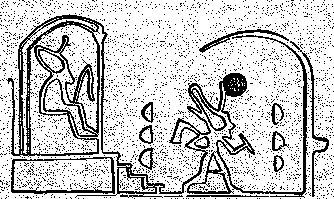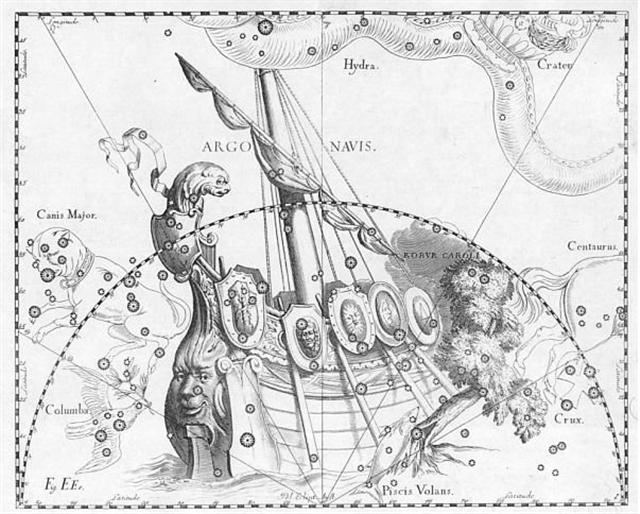5. The current day number for Rigel is 79, which is counted from its right ascension value 05h 12m (from spring equinox north of the equator) and according to my formula with 24 * 60 = 1440 minutes for a cycle (cfr at Te Varu Kainga), (5 * 60 + 12) / 1440 * 365¼ = 79:
My value 168º is based on a cycle with 360º, (11 * 60 + 14) / 1440 * 360 = 168½.
Maybe an idealized cycle with 360 days could have been used in some circumstances. On one side of Antares is his winter wife and on the other side his summer wife: ... An old native declared: 'Rehua is a star, a bird with two wings; one wing is broken. Under the unbroken wing is Te Waa-o-Tamarereti (the Canoe of Tamarereti is the Tail of Scorpius in this instance). When Rehua mates with his wife Pekehawani (a star close to Antares) the ocean is windless and motionless.' Antares, visible in the morning sky of December-January, came to stand for summer heat; hence the saying, 'Rehua cooks (ripens) all fruit'. The generally accepted version of the Rehua myth, according to Best, is that Rehua had two wives, the stars on either side of Antares. One was Ruhi-te-rangi or Pekehawani, the personification of summer languor (ruhi), the other Whaka-onge-kai, She-who-makes-food-scarce before the new crops can be harvested. In another old story Rehua mated with Puanga, Rigel, and their offspring were the clematis and another plant which were born in Mahuru, spring (August). They still suckle their mother during August and herald the coming of spring. Their birth was facilitated by Rua-moko, god of earthquakes, who marks the change of seasons ... If we should measure the cycle as 360 days, then there will be 168 days from Rigel to Antares:
And if we then change from the idealized value of 360 to the correct value of 365¼ days for a year, then there will be 168 days also to the end of summer.
It makes me remember how Taetagaloa saw that the 'canoe' was crooked: ... They go inland at the land. The child nursed and tended grows up, is able to go and play. Each day he now goes off a bit further away, moving some distance away from the house, and then returns to their house. So it goes on and the child is fully grown and goes to play far away from the place where they live. He goes over to where some work is being done by a father and son. Likāvaka is the name of the father - a canoe-builder, while his son is Kuikava. Taetagaloa goes right over there and steps forward to the stern of the canoe saying - his words are these: 'The canoe is crooked.' (kalo ki ama). Instantly Likāvaka is enraged at the words of the child. Likāvaka says: 'Who the hell are you to come and tell me that the canoe is crooked?' Taetagaloa replies: 'Come and stand over here and see that the canoe is crooked.' Likāvaka goes over and stands right at the place Taetagaloa told him to at the stern of the canoe. Looking forward, Taetagaloa is right, the canoe is crooked. He slices through all the lashings of the canoe to straighten the timbers. He realigns the timbers. First he must again position the supports, then place the timbers correctly in them, but Kuikava the son of Likāvaka goes over and stands upon one support. His father Likāvaka rushes right over and strikes his son Kuikava with his adze. Thus Kuikava dies. Taetagaloa goes over at once and brings the son of Likāvaka, Kuikava, back to life. Then he again aligns the supports correctly and helps Likāvaka in building the canoe. Working working it is finished ... The left side of the 'canoe' - which should have its bow adornment (rei-mua) at the beginning of summer - is not 168 days long, if measured from Rigel, but 171 days, a deviation with 3 days. Another explanation of the crooked canoe is to say that the distance from Aldebaran to Antares is 181 days but the distance from Antares to Aldebaran is 184 days. When Kuikava, the son, is struck down by the adze of his father it does sound somewhat like how north of the equator the feeble young son of Sun could not keep his father's chariot on its true course: ... In the story of Phaëton, which is another name for Helius himself (Homer, Iliad xi. 735 and Odyssey v. 479), an instructive fable has been grafted on the chariot allegory, the moral being that fathers should not spoil their sons by listening to female advice. This fable, however, is not quite so simple as it seems: it has a mythic importance in its reference to the annual sacrifice of a royal prince, on the one day reckoned as belonging to the terrestrial, but not to the sidereal year, namely that which followed the shortest day. The sacred king pretended to die at sunset; the boy interrex was at once invested with his titles, dignities, and sacred implements, married to the queen, and killed twenty-four hours later: in Thrace, torn to pieces by women disguised as horses ... but at Corinth, and elsewhere, dragged at the tail of a sun-chariot drawn by maddened horses, until he was crushed to death. Thereupon the old king reappeared from the tomb where he had been hiding ... as the boy's successor ... When Kuikava is brought back to life it presumably corresponds to how the king reappears from the tomb where he had been hiding, like Pharaoh in similar circumstances:
We should also remember how king Charles II hid in an oak for 24 hours (cfr at Niu and at Kai Viri):
|
||||||||||||||||||||||||||||||||||||||||||||||||||||||||||||||||||||||||||||||||||||||||||||||||||||||||



